Video conferencing is an online or virtual meeting, in which several parties in different locations carry out two-way interactions, through electronic voice and video communication platforms/applications [1].
The concept of video conference itself has been around for a long time, starting in the 1800s and 1900s [2]. However, at the time, this technology was impractical. In fact, the COVID-19 pandemic in 2020 played a big role in increasing the number of videoconferencing users.
Video conferencing platforms are frequently used to conduct online or virtual meetings, including private video calls, research meetings, and seminars. Many jobs now allow workers to work from anywhere (WFA) via video conference. This means that by using these platforms, you can still hold a meeting, even though it is online. Currently, various video conferencing platforms have sprung up, some of which have even made their names skyrocket during the COVID-19 pandemic.
List of video conferencing platforms
Here are some platforms that offer video conferencing services for holding online or virtual meetings. You are probably familiar with some of them.
1. Zoom
Surely you are probably familiar with the Zoom platform. Zoom is a communication platform that allows users to conduct online or virtual meetings through video and voice communication.
Its name soared during the COVID-19 pandemic [3], [4], and is the most downloaded and used application to date. In fact, it had a 42.7% market share by 2022 [5]. Not only educators, but business people also frequently use Zoom.
You can use Zoom directly in a browser or download it for free.
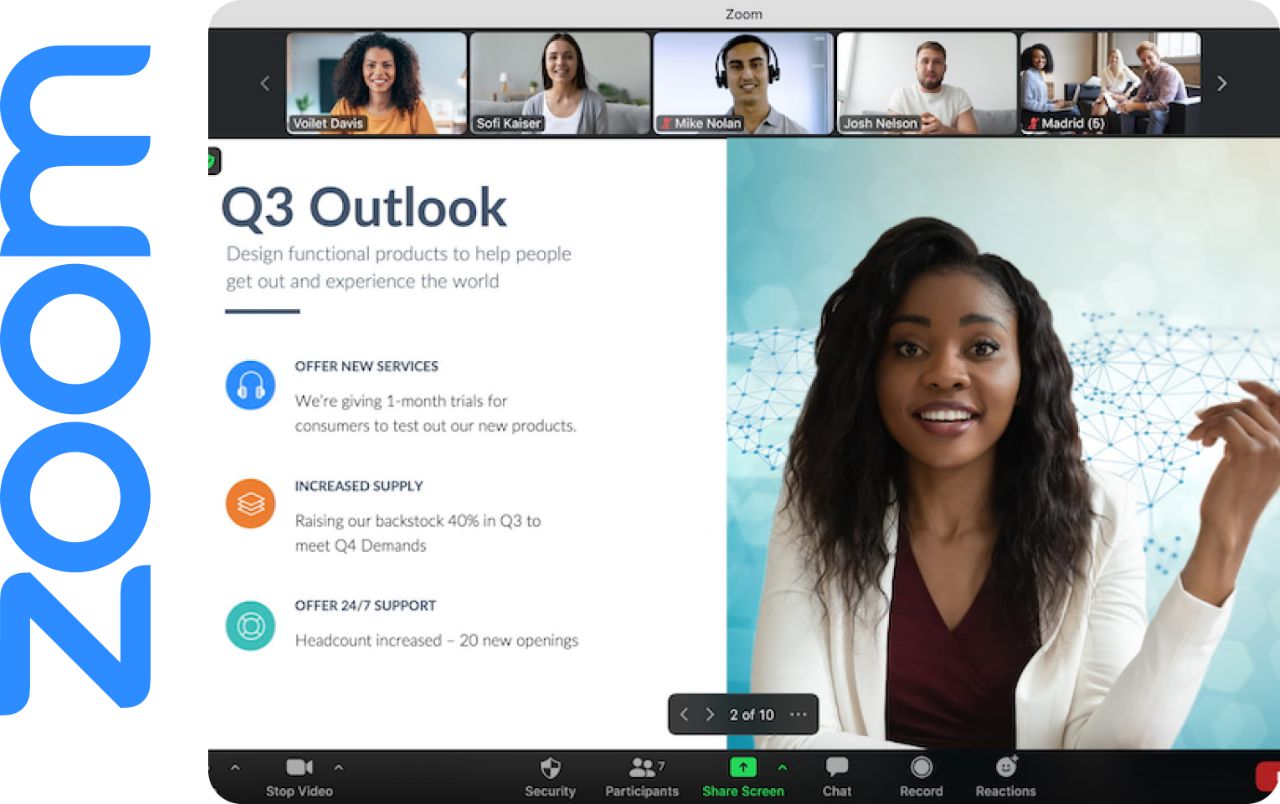
Zoom has a number of features that help to improve the quality of online meetings. For example, you can change the audio and video quality and background appearance, as well as the features for recording meetings.
Pros:
- Can conduct meetings of up to 100 people simultaneously.
- The audio and video quality is very good.
- There are video effect features such as blur background, filters, and avatars.
- There is a background noise suppression feature.
- Presentations are made simple by using share-screen, remote control, and a whiteboard.
- Supports desktop, web, and mobile devices.
Cons:
- The meeting duration is only 40 minutes on the free version.
- Requires a stable network and large bandwidth.
- Prone to data leakage [6].
- It tends to be easily infiltrated by malware from villainous people.
Subscription fee:
You can download and use Zoom for free or by subscription. However, the free version has limited features and a shorter online meeting duration. On the other hand, the paid version of Zoom offers more features and advantages, such as meeting durations of up to 30 hours. The Zoom subscription options are as follows (2023):
- The Pro Plan costs $14.99 per month,
- The Business Plan costs $19.99 per month, and
- The Enterprise Plan has even more features at a custom cost.
2. Google Meet
You may have heard of the Google Hangouts Meet app, which is currently Google Meet. Yes, Google Meet is one of Google’s services for conducting video conference quickly and easily. In fact, if a host uses a Gmail education account, the Google Meet feature limitations have been lifted.
Due to its convenience, Google Meet has a market share of 31.4% (2022) and continues to increase rapidly from year to year [5]. Google Meet, which is used to conduct online or virtual meetings, is currently the second-most widely used video conferencing platform. Although simple, Google Meet has many sophisticated and competitive features. Without having to download anything, you can immediately try Google Meet on their site for free.
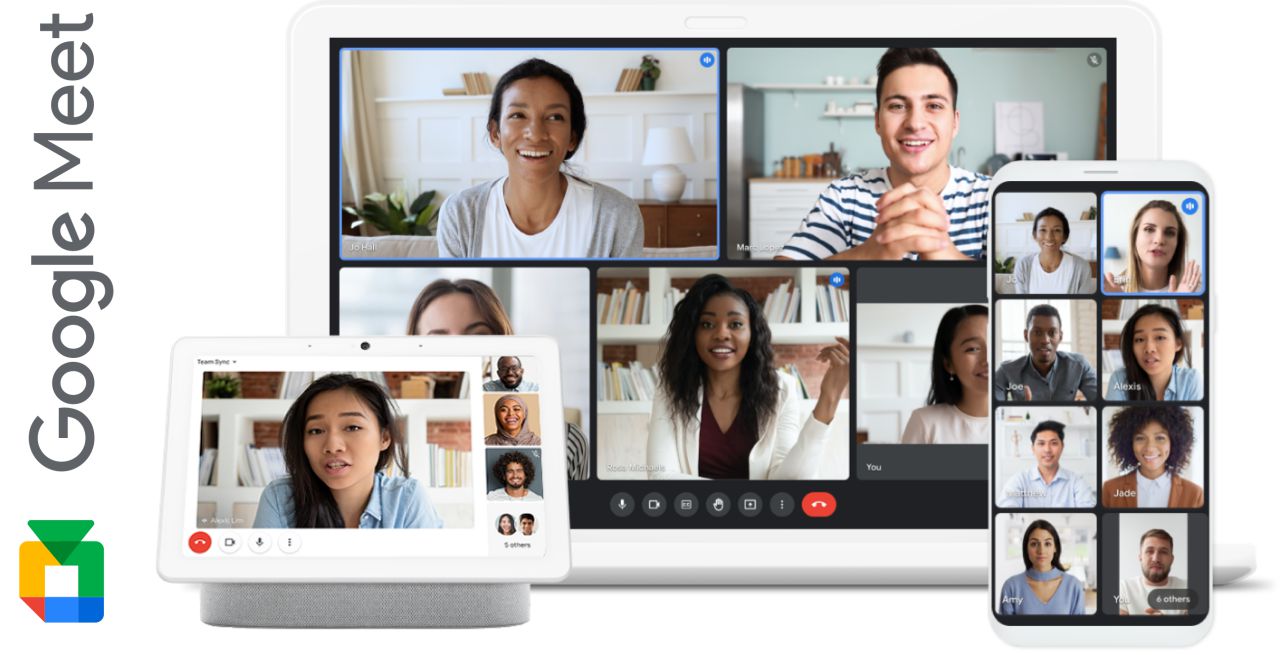
You can use it only through a browser, such as Chrome or Mozilla Firefox. Apart from that, Google Meet has also been integrated with several other Google services, such as Google Docs, Google Slides, and Google Sheets.
With Google Meet, you can make presentations via the share screen feature. Furthermore, the number of participants who can join a single meeting is up to 500 (for business or enterprise version accounts).
Pros:
- Can conduct meetings of up to 100 people simultaneously.
- Simple, lightweight, and can be accessed via a browser.
- Provides essential features such as whiteboards, group chat, and screen sharing.
- Integrates with many Google apps.
- Has a good security system.
Cons:
- The default screen share quality is extremely low [7], which may require changing settings when needed.
- The maximum duration of a meeting is only 60 minutes on a free account.
- Recording features and breakout rooms are missing in the free version.
Subscription fee:
Meanwhile, to get more complete features and avoid the 60-minute limit, you have to spend money to upgrade your Google account to:
- Business Starter, which costs $6 per month,
- Standard Business, which costs $12 per month,
- Business Plus, which costs $18 per month, or
- Enterprise and Education at a custom cost.
3. Microsoft Teams
As the name implies, Microsoft Teams is a collaboration, chat, and video conferencing platform made by Microsoft that is integrated with Office 365 services. It is the third most popular platform for conducting online or virtual meetings. It had a market share of 10.9% in 2022 [5].
There are two ways to use Microsoft Teams. First, you can directly use Microsoft Teams through the browser. Second, you can download the desktop or mobile version for free through the Microsoft website or the Microsoft Store.
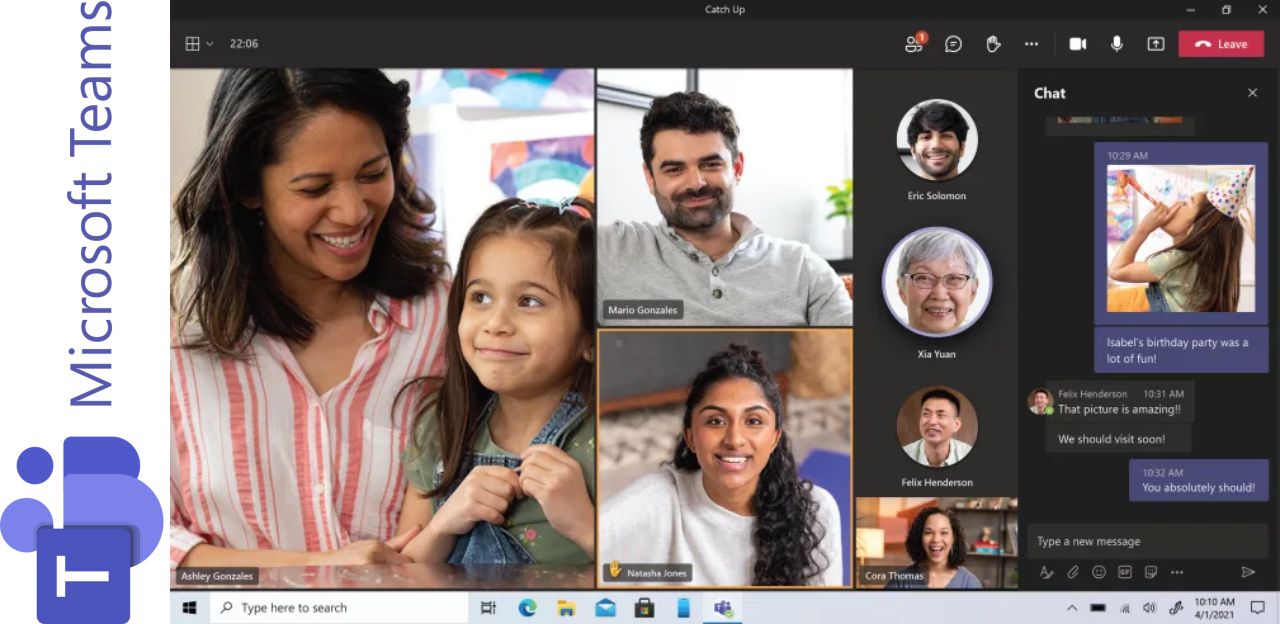
Because it has been integrated with Office 365, searching, sharing, and editing Word, PowerPoint, and Excel files online and in real time is easy [8]. You can also integrate Microsoft Teams with Microsoft Outlook to schedule the online or virtual meetings [9].
Pros:
- Can conduct meetings of up to 100 people simultaneously.
- Supports desktop, web, and mobile devices.
- Has a guaranteed level of data security.
- A recording feature is available and is automatically saved to the cloud.
- Provides automatic transcripts.
- Tolerant to a less stable internet connection.
Cons:
- On a free account, the maximum duration of a meeting for more than two people is only 60 minutes.
- Requires large storage space.
- Data security risks exist when inviting people from outside the company (guests).
- Collaboration settings are too complex.
Subscription fee:
Meanwhile, Microsoft Teams offers a premium version at a relatively affordable cost. There are two main ways to obtain it (2023):
- Subscribe to Microsoft Teams Essentials for $4.00 per month, or
- Subscribe to Microsoft 365, with several options:
- Microsoft 365 Personal costs $6.99 per month,
- Microsoft 365 Family costs $9.99 per month,
- Microsoft 365 Business Basic costs $6.00 per month,
- Microsoft 365 Business Standard costs $12.50 per month, and
- Microsoft 365 Business Premium costs $22.00 per month.
Each option offers different features and advantages. So, you need to adjust which package suits your needs and budget.
4. Skype
In fact, other than the several platforms that were mentioned earlier, Skype has already existed since 2003. Currently, Skype is a division of Microsoft that offers VoIP (Voice over Internet Protocol) services to make or receive video and voice calls, send messages, and share files for free [10].
In fact, the main purpose of the Skype platform is to provide instant communication with family or business partners, like WhatsApp, LINE, or similar applications. As a result, its market share for as a video conferencing platform is only around 6% (2022) [5]. It is lower when compared to Microsoft Teams. However, unlike other applications, Skype can be used to hold online or virtual meetings with a longer duration for free.
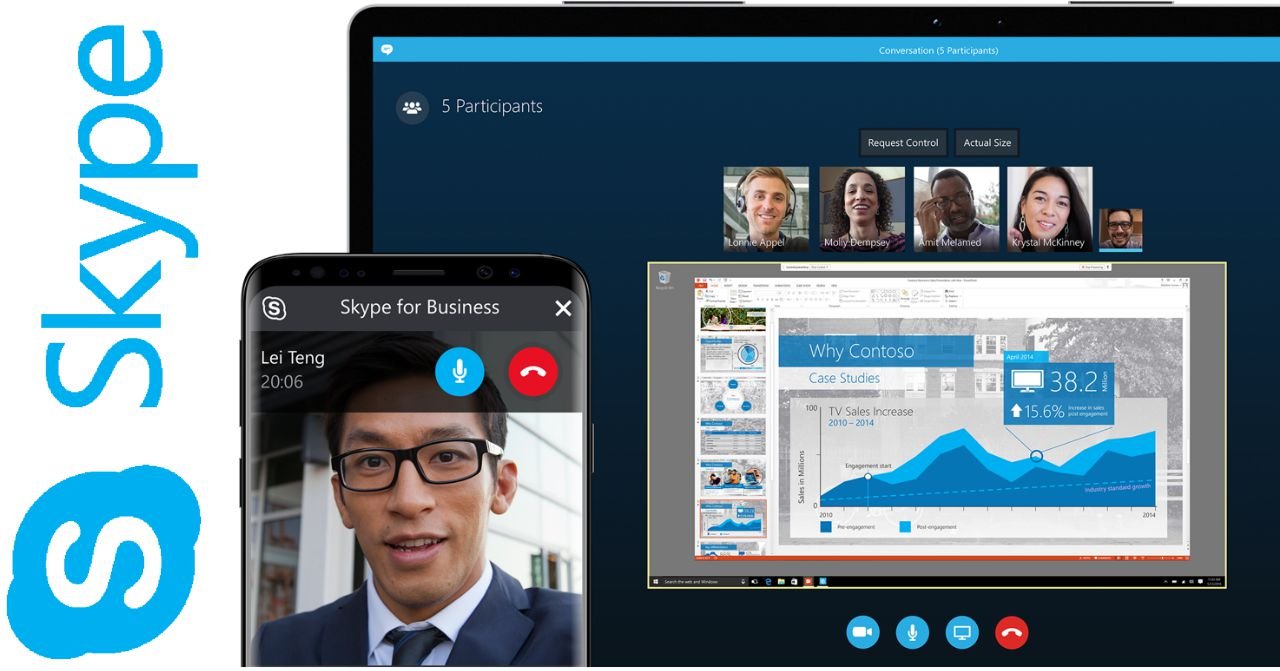
There are two ways to use Skype. First, you can directly use Skype through the browser. Second, you can download the desktop or mobile version for free through the Microsoft website or the Microsoft Store.
Pros:
- Longer duration of online or virtual meetings for free.
- Supports a variety of devices, such as mobile, desktops, tablets, web, Alexa, and Xbox.
- There is a share-screen feature even in the free version.
Cons:
- There is a maximum of 50 people per meeting.
- Rarely used as a video conferencing platform.
- For the web version of Skype, only Microsoft Edge and Google Chrome are officially supported.
Subscription fee:
Skype Group Video Chat is free to use for online or virtual meetings. On the other hand, a Skype subscription, starting at $3.49 per month, is only needed if you want a Skype number that can be called from any country.
That is, if you want to have an online or virtual meeting with more than 50 people, then you need to use another video conferencing platform.
5. Webex Meetings
Webex Meetings is a Cisco service that offers video conferencing with advanced features such as screen sharing, meeting transcription, and other features supported by artificial intelligence (AI).
This platform is not as popular as Zoom or Google Meet, with a market share of only around 2.1% (2022) [5]. However, one of Webex’s strengths is the high quality of the videos. You can even do a high-quality video conference if you have a fast and stable internet connection.
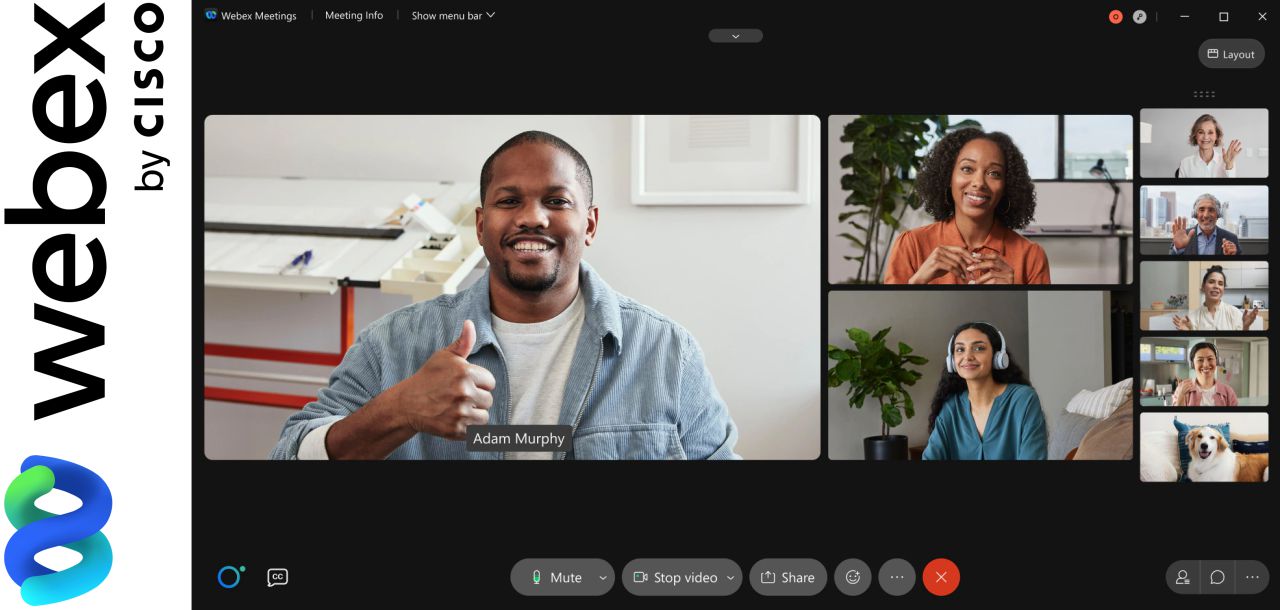
You can directly join an online or virtual meeting via your browser. Webex Meetings is also free to download for desktop and mobile. This application can also be used to hold meetings or online meetings during the pandemic.
Pros:
- Can conduct meetings of up to 100 people simultaneously.
- There are virtual background features, such as blur filters or changing background images.
- There is a Webex smart audio feature, to eliminate background noise.
- Breakout rooms are featured in the free version.
- Content sharing feature.
- Easy presentation through a shared screen or interactive whiteboarding.
- has a reputation for high-quality, guaranteed security systems.
Cons:
- The maximum duration is only 40 minutes on a free account.
- Access to the website version sometimes has problems.
- If you have an unstable internet connection, you may have difficulties using the content sharing feature.
- The user interface tends to be complex.
Subscription fee:
Meanwhile, to get more complete features and avoid the 40-minute limit, you can choose one of the following subscription options:
- Starter plan costs $14.50 per month,
- The Business plan costs $20 per month, or
- Enterprise Plan, which offers more features at a custom cost.
Other platforms
Slack, GoToMeeting, and AnyMeeting are just a few of the other video conferencing platforms available for online or virtual meetings. Although each has its pros and cons, they only have a small market share.
Which one is your favorite video conferencing platform?
This is a list of video conferencing platforms that can be used to hold online or virtual meetings. Indeed, each platform presents interesting features with different subscription fees. Ultimately, you need to choose one of the videoconferencing platforms that best suits your needs.
So far, which platforms do you use the most? Are you satisfied with the platforms? Please write about your experience in the comments column.
References
- [1]Collins Dictionaries, “videoconference,” Collins Dictionaries. https://www.collinsdictionary.com/dictionary/english/video-conference (accessed Feb. 07, 2023).
- [2]A. Patrizio, “The history and evolution of video conferencing,” TechTarget, Aug. 17, 2021. https://www.techtarget.com/whatis/feature/The-history-and-evolution-of-video-conferencing (accessed Feb. 07, 2023).
- [3]R. Molla, “The pandemic was great for Zoom. What happens when there’s a vaccine?,” Vox Media, Dec. 04, 2020. https://www.vox.com/recode/21726260/zoom-microsoft-teams-video-conferencing-post-pandemic-coronavirus (accessed Feb. 07, 2023).
- [4]BBC News, “Zoom sees more growth after ‘unprecedented’ 2020,” British Broadcasting Corporation (BBC), Mar. 01, 2021. https://www.bbc.com/news/business-56247489 (accessed Feb. 07, 2023).
- [5]R. Brandl, “The Most Popular Video Call Conferencing Platforms Worldwide,” ToolTester Network, Jan. 04, 2023. https://www.emailtooltester.com/en/blog/video-conferencing-market-share/ (accessed Feb. 07, 2023).
- [6]A. Spadafora, “Zoom security issues: What’s gone wrong and what’s been fixed,” Tom’s Guide, Jan. 20, 2023. https://www.tomsguide.com/news/zoom-security-privacy-woes (accessed Feb. 07, 2023).
- [7]J. Thompson, “Question: Improving screenshare quality in Google Meet?,” Stack Exchange, Apr. 23, 2020. https://webapps.stackexchange.com/questions/141674/improving-screenshare-quality-in-google-meet (accessed Feb. 07, 2023).
- [8]Microsoft Teams, “Microsoft Teams: Make amazing things happen together at home, work, and school,” Microsoft. https://www.microsoft.com/en-us/microsoft-teams/group-chat-software (accessed Feb. 07, 2023).
- [9]Microsoft Teams, “Schedule a Teams meeting from Outlook,” Microsoft. https://support.microsoft.com/en-us/office/schedule-a-teams-meeting-from-outlook-883cc15c-580f-441a-92ea-0992c00a9b0f (accessed Feb. 07, 2023).
- [10]Skype, “What is Skype?,” Microsoft. https://support.skype.com/en/faq/FA6/what-is-skype (accessed Feb. 07, 2023).
Cover image by tirachardz on Freepik



